I am interested in studying the star-formation properties of low-mass galaxies at a variety of different redshifts to better understand their role in the model of galaxy formation and evolution with the help of a variety of different projects that I am involved in.
Scientific Motivation
The growth of galaxies is predominantly governed by the baryonic physics that convert gas into stars, i.e., star-formation. Current galaxy formation models are fairly successful for the high-mass galaxies, but often have difficulties in reproducing the properties of low-mass galaxies, which may be indicative of an incomplete understanding of the details of the baryonic physics that govern star-formation in galaxies. The faint, low-mass galaxies may hold the missing pieces to finish the grand puzzle of galaxy formation and evolution.
Research Areas
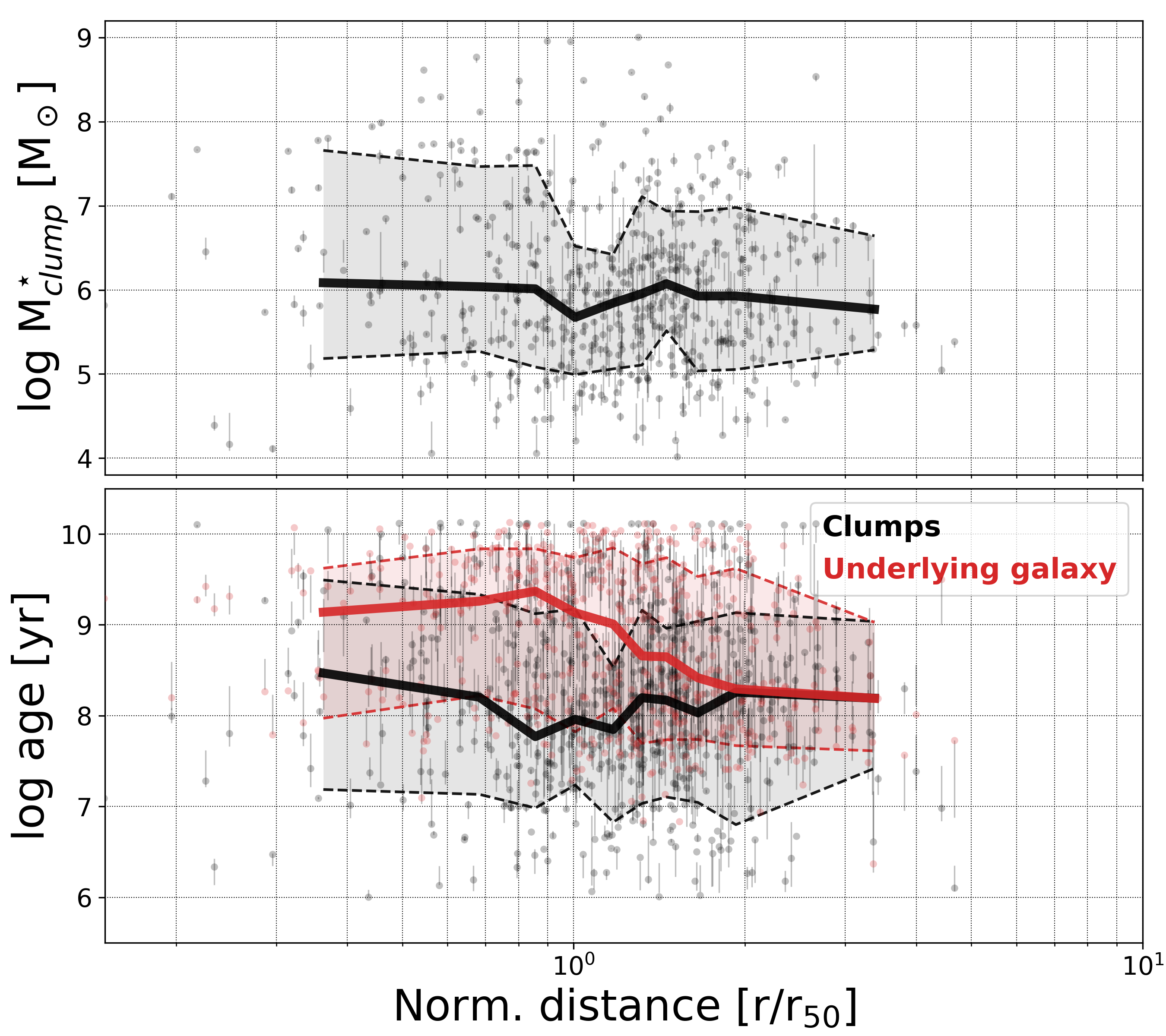
The galaxies that we see today in the local Universe assembled most of their mass at the peak of the cosmic star-formation history at z~2. The galaxies at z~2 exhibit physical properties that are significantly different compared to the present day galaxies. They tend to have higher gas fractions, irregular morphologies, and chaotic dynamics all of which may contribute towards their high star-formation rates. One of the key features present in these high-redshift galaxies are star-forming clumps. It is still unclear how clumps affect the growth of a galaxy and their role in the grander puzzle of how galaxies grow and evolve through cosmic time.
Mehta et. al (2021) presents an analysis of properties of star-forming clumps in SDSS galaxies (z<0.06) that were identified as clumpy in the Galaxy Zoo citizen science project. While the overall properties of the clumps in these galaxies are comparable to their high-redshift counterparts, we find no evidence of a gradient in clump ages or masses as a function of their galactocentric distances. This result presents a challenged to the inward migration scenario of clump evolution in the local universe, potentially suggesting a larger contribution of ex-situ clumps and/or longer clump migration timescales.

Furthermore, I helped launch a new citizen science project, Clump Scout, with explicit focus on locating clumps in SDSS galaxies. Adams et. al (2022) presents an overview of the project and our initial results that lend support to the idea that clump formation is primarily driven by violent disk instabilities. While the project is officially complete, if you want to experience the joy of finding clumps, you can still participate in the Clump Scout adventure – just head over to this link.
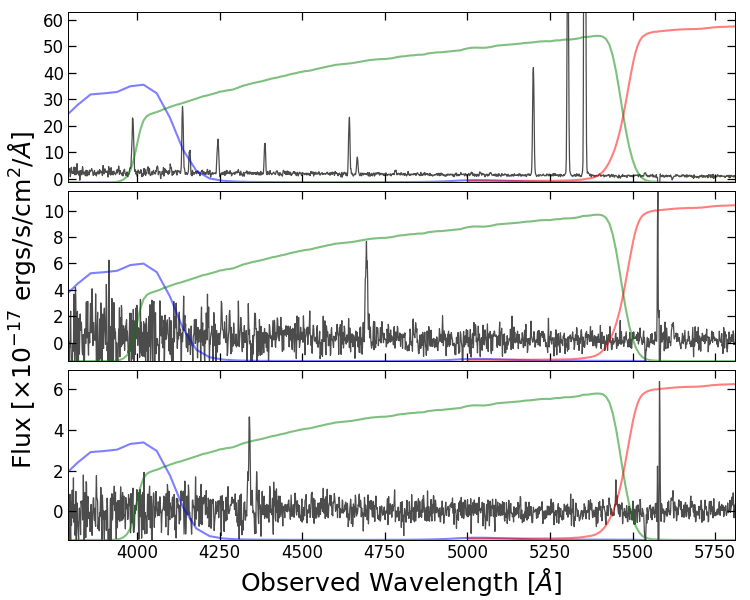
Low-mass galaxies can produce extremely strong emission lines when undergoing an episode of star-formation. These emission lines are often strong enough to even affect the broadband photometry of these otherwise faint galaxies. Currently, I am studying these high-EW emission line galaxies selected by their broadband colors from the SPLASH-SXDF catalog. These galaxies have an emission line strong enough to create a detectable excess in the broadband magnitude. For optical broadband filters, the emission line causing the excess is likely to be [OIII]λ4959+5007Å doublet or Lyα. In case it is the [OIII] doublet, these objects are the local, much lower mass analogs of the "Green Pea" galaxies identified in SDSS. In case it is Lyα, these galaxies are Lyman-alpha Emitters (LAEs) with high Lyα EW which may be indicative of exotic systems or extremely low metallicity stellar populations.

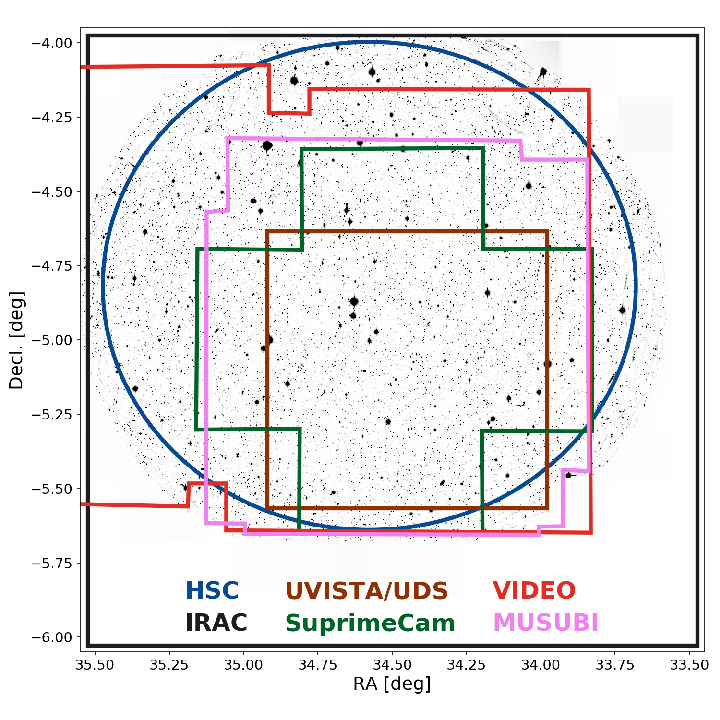
SPLASH covers two of the largest contiguous fields, Cosmic Evolution Survey field (COSMOS) and Subaru-XMM Deep survey Field (SXDF), with deep Spitzer-warm observations to accompany the optical observations from the Hyper-Suprime Cam (HSC). In the past year, I have collected the SPLASH data on the SXDF along with all available optical and NIR archival imaging data to generate a multi-wavelength photometric catalog. In order to ensure photometry is measured in a uniform fashion across the full wavelength range as well as the range of instruments and observing strategies, the data have been resampled to a uniform pixel scale, corrected for astrometric distortions, PSF homogenized, and have the photometric errors adjusted to be consistent across all bands. Mehta et. al (2018) presents the final multi-wavelength catalog with photometry in 28 bands spanning from optical to MIR as well as photometric redshifts and physical properties for about 1.17 million objects over 4.3 deg2 in the SXDF. This dataset is ideal for selecting statistically significant samples of rare objects such as the extreme emission line galaxies.

Using the deepest direct (non-lensed) imaging data available from the UVUDF, I measured the rest-UV LFs at z~1-3 in Mehta et. al (2017). The Ultra-Violet Ultra Deep Field (UVUDF; PI. H. Teplitz) survey pushes ~2 magnitudes fainter than previous blank field surveys and is perfectly suited to measure the faint-end slope of the LF directly from unlensed galaxies.
Futhuremore, I compare the rest-UV as a star-formation indicator to the "golden standard" of star-formation indicators, Hα. By “abundance-matching” the rest-UV and Hα LFs, in Mehta et. al (2017), I computed a volume-averaged empirical dust-corrected UV-to-Hα ratio and find that the trend deviates from the constant SFH expectation as a function of the luminosity (and consequently, mass). With dust correction issues, stochastic IMFs, and metallicity variations being able to be ruled out, the only explanation for the observed trend in UV-to-Hα ratio is a combination of incomplete dust correction and bursty SFHs. At the bright end, it is likely that a population of dusty star-forming galaxies is not properly accounted for by the generic relations (IRX-β) used to correct the observed UV flux for dust. At the low-mass end, there must be a larger contribution from galaxies with bursty SFHs compared to their high-mass counterparts.
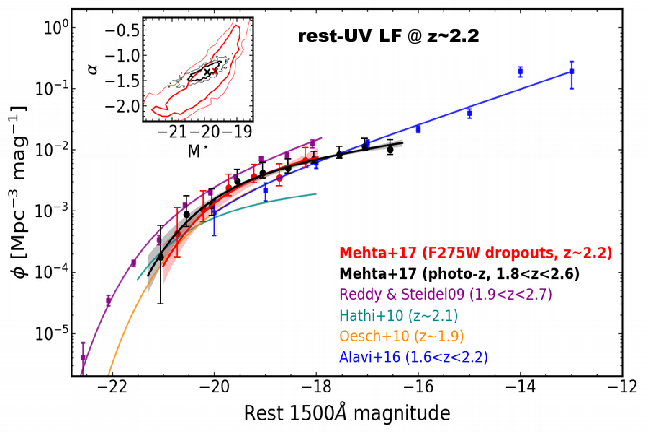
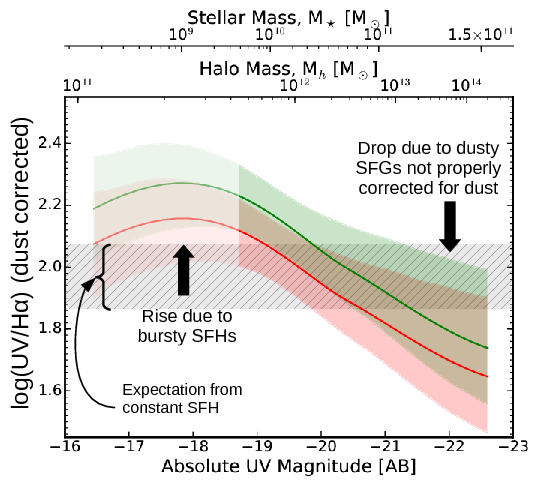

![WISP Ha-[OIII] bivariate LF](images/WISP.png)
Future missions such as Euclid and WFIRST-AFTA that plan to study the nature of dark energy are reliant on achieving their critical figure-of-merit. This key statistic is dependent on the number of emission line galaxies (particularly, Hα) that will be observable by these surveys. Both Euclid and WFIRST-AFTA plan to conduct slitless grism observations over a large area, similar to the on-going WFC3 Infrared Spectroscopic Parallel (WISP) survey which covers a much smaller area using HST. The similarity of WISP to the future missions makes it the perfect pilot to estimate the number counts; however, the wavelength coverage of WISP stops blueward of the planned coverage for the future surveys.
In Mehta et al. (2015), I developed a novel approach to estimate the Hα number counts for the redshift range where WISP does not cover Hα using the observed [OIII] emitters, that are available to higher redshifts. At lower redshift where both Hα and [OIII] are available, I measure the Hα-[OIII] bivariate luminosity function which is then used to estimate the Hα number counts using the measured [OIII] luminosity function at higher redshift.